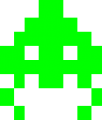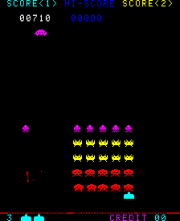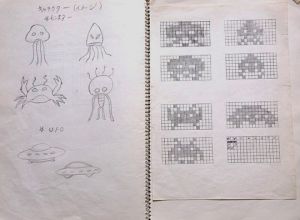Space Invaders
Space Invaders is an arcade game published by Taito Co., Ltd. in 1978. Space Invaders is the biggest hit in the history of arcade games and the earliest example of a single-player shooting game. Similar products and bootlegs have been made by other companies such as Irem's IPM Invader.
Contents
Gameplay Overview
Each level tasks the player with destroying an 11 x 5 grid of aliens. The wave initially moves right, shifting down a row and reversing direction upon reaching either side of the screen. The speed of the wave is divided by the number of aliens (since only one can be updated each frame). Consequently, as aliens are killed the rest become exponentially faster. The cannon can only move horizontally, and shoot straight up. Only one player shot may be onscreen at a time. Each level has four destructible shields that block both player and enemy shots. The player starts with three cannons and can earn a fourth by obtaining 1500 points. If all cannons are lost OR the aliens reach the bottom of the screen, the game ends.
Controls
- Joystick / Left & Right Buttons: Horizontal movement
- Shoot Button (Press): Fire
Scoring
- Octopus : 10 points.
- Crab : 20 points.
- Squid : 30 points.
- UFO : ??? (50, 100, 150, or 300) points.
Characters
Strategy
Basic Tips
- Shoot often. Each time an alien is hit the wave stops for 16 frames.
- Don't miss. Each missed shot is a 62 frame penalty (45 to cross the screen, 16 to explode, 1 to input the next shot).
- Destroy the wave's outer columns to decrease its width. This is the only way to permanently slow the invasion.
- Destroy the wave's inner columns to create a moving safe zone that aliens cannot cross.
- Position the cannon's center just past the edge of a shield to shoot while being protected on one side.
Intermediate Tips
- Aim for the sides of aliens rather than their centers. This decreases the chance of shots being canceled by enemy fire.
- The faster the aliens, the safer it is to intercept them and the riskier it is to chase them.
- Always assume alien shots will squeeze through damaged barriers. Always assume alien shots will pierce through cannon shots.
- If aliens cannot be shot, shoot small shield pieces that might get in the way later.
- The last alien moves 50% faster when moving right instead of left. Practice hitting it at both speeds.
Advanced Tips
- If an alien is directly above a barrier, it can be hit indirectly with a bullet explosion.
- If an alien is directly above a barrier, its shots can spawn past the thinner center.
- An exploding alien prevents the wave from moving or attacking for 16 frames. Use this to setup another attack or pass a low column.
- "Rolling" shots target the player. "Plunger" shots appear in columns 1,7,1,1,1,4,11,1,6,3,1,1,11,9,2,8. "Squiggly" shots appear in columns 11,1,6,3,1,1,11,9,2,8,2,11,4,7,10. These numbers are taken from the same table (the overlap is bolded). If a column is missing it is skipped. Column 1 is the most common target, followed by column 11.
- Since enemy shots are not truly random, it's possible to memorize their behavior (to an extent). This can be useful at the start of a wave.
UFOs
Although UFO score was intended to be random, it actually cycles through the following numbers with each player shot: (50,50,100,150,100,100,50,300,100,100,100, 50,150,100,100)
- By hitting UFOs with the 23rd shot and every 15th shot afterward, each will award 300 points.
- If a UFO awards 50 or 100 points, that means the player under- or overcounted by one.
- Without shot counting, UFOs award about 100 points on average.
- The shot count can be increased quickly by hitting shields.
- A UFO appears every 25.6 seconds. By destroying 4 outer columns (so 7 remain) the invasion will last as long as possible.
- Squiggly shots don't appear while a UFO is onscreen. This makes it a little safer to maneuver around aliens.
- Although difficult, it's always possible to shoot between columns to hit a UFO.
- With 8 aliens left their shots become 25% faster. With 7 left UFOs stop appearing.
Nagoya Attack
The Nagoya Attack (also known as the "Wall of Death") takes advantage of a bug wherein aliens on the last row spawn their bullets below the cannon. By creating a safe space and only attacking enemies on the final row, the player is effectively invincible. At the same time, leaving most aliens alive until the last second slows the game so more UFOs can be shot. However, failing to destroy the last row perfectly results in the game ending instantly. This strategy is named after the city in Japan where it was presumably discovered.
This video demonstrates two common variations of the Nagoya Attack: https://www.youtube.com/watch?v=Ty2z6KP5X0Y
Trivia
- If the last alien of a wave is an octopus it creates a trail while moving right. This visual bug, nicknamed "rainbow", became a scoring feature in Space Invaders Part II.
- Space Invaders was inspired by the 1976 arcade game Breakout. Both games become more difficult as the number of targets decreases while the pace of gameplay increases.
- June 16th is officially recognized as "Space Invaders Day".
References
- https://en.wikipedia.org/wiki/Space_Invaders
- https://ja.wikipedia.org/wiki/スペースインベーダー
- strategy guides
- Developer Interview "Looking back when Space Invaders was born"









